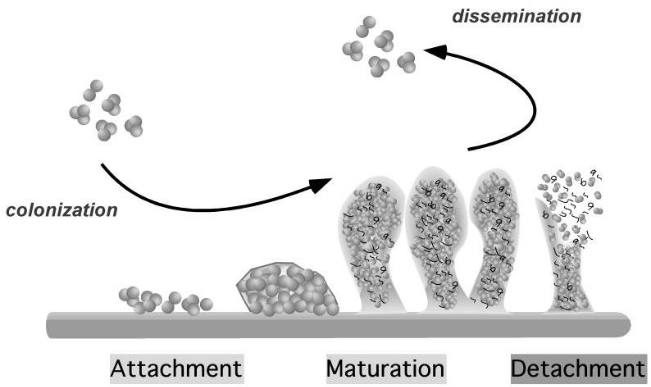The biofilm formation process can be divided into distinct phases. First the planktonic bacteria attach to a biotic or abiotic surface. In the next phase, the biofilm maturation, the bacteria multiply, form microcolonies and produce an extracellular matrix which consists of exopolysaccharides, proteins, teichoic acids and extracellular DNA. In the last phase, the bacteria detach from the biofilm, spread and can cause new infections. When growing in a biofilm, S. aureus persist on implanted medical devices such as catheters and prosthetic joints as well as on host tissues such as bone and heart valves, leading to chronic osteomyelitis and native valve endocarditis. Biofilm-associated infections are often chronic and relapsing, highly resistant against attacks of the immune system and extremely difficult to treat with antibiotics. Antibiotic resistance of bacteria within a biofilm may result from slow metabolism, phenotypic heterogeneity, persister cell formation, inactivation or slower penetration of the antibiotic. Therefore the bacterial cells in the biofilm matrix may encounter subinhibitory concentrations of antibiotics which in turn lead to changes in biofilm formation and biofilm matrix composition. Given the important role of biofilm-associated infections of S. aureus, it is crucial to better understand the molecular mechanisms leading to biofilm formation and changes in the biofilm matrix, especially in response to subinhibitory concentrations of clinically relevant antibiotics. This will help to develop new and better treatment strategies for biofilm-associated infection.
In a translational approach we are examining infected foreign material from patients aiming to better understand, characterize and diagnose biofilm infections as part of a joint effort (VASGRA and Balgrist).

Figure: Phases of biofilm development in staphylococci. Figure modified from Otto et al., Staphylococcal biofilms. Curr Top Microbiol Immunol 2008; 322: 207-28.